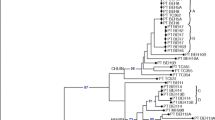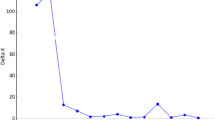Abstract
In this work, a set of pea accessions obtained from the Vavilov Research Institute (VIR) collection comprising 83 P. sativum samples, including representatives of three subspecies, was studied using the AFLP method. Local cultivars for different uses with maximum ecological and geographical diversity (including those from the centers of origin of the species) were predominantly chosen for the study; a number of their morphological and biological characteristics were evaluated. We obtained 382 polymorphic AFLP fragments; each sample was characterized by a unique set of fragments. The genetic diversity of the studied material was evaluated, and a wide range of genetic differences in the investigated samples (0.07–0.27) was demonstrated. The affiliation of the samples to the certain subspecies was not confirmed by the obtained data; the ecogeographical differentiation of the samples was not reflected by the data. Factor analysis allowed us to identify the sample groups of European and Asian origin and the intermediate nature of most of the samples from the studied set of pea accessions.
Similar content being viewed by others
References
Vavilov, N.I., The origin of world agriculture in the light of modern research, in Izbrannye trudy v pyati tomakh: Problemy proiskhozhdeniya, geografii, genetiki, selektsii rastenii, rastenievodstva i agronomii (Selected Writings in Five Volumes: Origin, Geography, Genetics, Breeding of Plants, Plant Industry, and Agronomy), Moscow: Nauka, 1965, pp. 143–152.
Smy-kal, P., Kenicer, G., Flavell, A.J., et al., Phylogeny, phylogeography and genetic diversity of the Pisum genus, Plant Genet. Resour. Charact. Util., 2011, vol. 9, pp. 4–18.
Makasheva, R.Kh., Kul’turnaya flora SSSR (Flora of Cultivated Plants of the Soviet Union), vol. 4: Zernovye bobovye kul’tury (Grain Legumes), part 1: Gorokh (Pea), Leningrad: Kolos, 1979.
van der Maesen, L.J.G., Wild plants as genetic resources for crop improvement, in Diversity and Taxonomy of Tropical Flowering Plants, Mathew, P. and Sivadasan, M., Eds., Calicut: Mentor Books, 1998, pp. 93–112.
Govorov, L.I., Flora of Cultivated Plants of the USSR, vol. 4: Grain Leguminosae, Moscow, 1937, pp. 231–236.
Zohary, D. and Hopf, M., Domestication of pulses in the Old World, Science, 1973, vol. 182, pp. 887–894.
Vershinin, A.V., Allnutt, T.R., Knox, M.R., et al., Transposable elements reveal the impact of introgression, rather than transposition, in Pisum diversity, evolution, and domestication, Mol. Biol. Evol., 2003, vol. 20, no. 12, pp. 2067–2075.
Maxted, N. and Ambrose, M., Plant genetic resources of legumes in the Mediterranean, in Peas (Pisum L.), Maxted, N. and Bennett, S.J., Eds., Kluwer, 2001, vol. 39, pp. 181–190.
Smykal P., Coyne C.J., Redden R.J., and Maxted, N., Genetic and genomic resources for grain legume improvement, in Peas, Singh, M. and Bisht, I.S., Eds., London: Elsevier, 2013, chapter 3, pp. 41–80.
Kupicha, F.K., Advances in legume systematics, in Vicieae, Polhill, R.M. and Raven, P.M., Eds., Kew Royal Botanic Gardens, 1981, pp. 377–381.
Posvec, Z. and Griga, M., Utilization of isozyme polymorphism for cultivar identification of 45 commercial peas (Pisum sativum L.), Euphytica, 2000, vol. 113, pp. 251–258.
Simioniuc, D., Uptmoor, R., Friedt, W., and Ordon, F., Genetic diversity and relationships among pea cultivars revealed by RAPDs and AFLPs, Plant Breed., 2002, vol. 121, pp. 429–435.
Zon, X., Guan, J.P., Wang, S.M., and Liu, Q.C., Genetic diversity among Chinese pea (Pisum sativum L.) landraces as revealed by SSR markers, Acta Agron. Sin., 2008, vol. 34, pp. 1330–1338.
Jing, R., Vershinin, A., Grzebyta, J., et al., The genetic diversity and evolution of field pea (Pisum) studied by high throughput retrotransposon based insertion polymorphism (RBIP) marker analysis, BMC Evol. Biol., 2010, vol. 10, p. 44.
Jing, R., Ambrose, M.A., Knox, M.R., et al., Genetic diversity in European Pisum germplasm collections, Theor. App. Genet., 2012, vol. 125, no. 2, pp. 367–380.
Vishnyakova, M.A., Burlyaeva, M.O., Buravtseva, T.V., et al., Identification of the genetic diversity of leguminous collection of Vavilov All-Russian Research Institute of Plant Industry by RAPD marker analysis of samples, in Molekulyarnaya i prikladnaya genetika (Molecular and Applied Genetics), Inst. Genet. Tsitol. Natl. Akad. Nauk Belarusi, 2011, vol. 12, pp. 80–89.
Kochieva, E.Z. and Ryzhova, N.N., Molecular AFLP analysis of the genotypes of pepper Capsicum annuum cultivars, Russ. J. Genet., 2003, vol. 39, no. 12, pp. 1345–1348.
Sardaro, M.L.S., Atallah, M., Picarella, M.E., et al., Genetic diversity, population structure and phylogenetic inference among Italian orchids of the Serapias genus assessed by AFLP molecular markers, Plant Syst. Evol., 2012, vol. 298, no. 9, pp. 1701–1710.
Borisov, A.Yu., Tsyganov, V.E., Yakobi, L.M., et al., Pea: Symbiotic Effectiveness, issue 728 of Katalog mirovoi kollektsii VIR (Catalogue of the World Collection of the Vavilov All-Russian Research Institute of Plant Industry), St. Petersburg, 2002.
Ryzhova, N.N., Slugina, M.A., Kochieva, E.Z., and Skryabin, K.G., Polymorphism and structural variation of rps16 group-II intron in the Solanum species, Russ. J. Genet., 2013, vol. 49, no. 7, pp. 717–721.
Vos, P.R., Hogers, M., Bleeker, M., et al., AFLP: a new technique for DNA fngerprinting, Nucleic Acids Res., 1995, vol. 23, pp. 4407–4414.
Sneath, P.H.A. and Sokal, R.R., Numerical Taxonomy: The Principles and Practice of Numerical Classification, San-Francisco: Freeman, 1973.
Pritchard, J.K., Stephens, M., and Donnelly, P., Inference of population structure using multilocus genotype data, Genetics, 2000, vol. 155, pp. 945–959.
Choudhury, P.R., Tanvee, H., and Dixit, G.P., Identification and detection of genetic relatedness among important varieties of pea (Pisum sativum L.) grown in India, Genetics, 2007, vol. 130, pp. 183–191.
Smykal, P., Horacek, J., Dostalova, R., and Hybl, M., Variety discrimination in pea (Pisum sativum L.) by molecular, biochemical and morphological markers, J. Appl. Genet., 2008, vol. 49, pp. 155–166.
Tar’an, B., Zhang, C., Warkentin, T., et al., Genetic diversity among varieties and wild species accessions of pea (Pisum sativum L.) based on molecular markers and morphological/physiological characters, Genome, 2005, vol. 48, pp. 257–272.
Barange, A., Aubert, G., Arnau, G., et al., Genetic diversity within Pisum sativum using protein-and PCR-based markers, Theor. Appl. Genet., 2004, vol. 108, pp. 1309–1321.
Jing, H., Wang, Z., and Chen, Y., Effect of oestradiol on mast cell number and histamine level in the mammary glands of rat, Anat. Histol. Embryol., 2011, vol. 41, pp. 170–176.
Vavilov, N.I., World plant resources and their use in breeding, in Izbrannye trudy v pyati tomakh: Problemy proiskhozhdeniya, geografii, genetiki, selektsii rastenii, rastenievodstva i agronomii (Selected Writings in Five Volumes: Origin, Geography, Genetics, Breeding of Plants, Plant Industry, and Agronomy), Moscow: Nauka, 1965, vol. 3, pp. 474–491.
Berdnikov, V.A., Bogdanova, V.S., Rozov, S.M., and Kosterin, O.E., The geographic patterns of histone H1 allelic frequencies formed in the course of pea (Pisum sativum L.) cultivation, Heredity, 1993, vol. 71, pp. 199–209.
Mitrofanova, O.P., Strel’chenko, P.P., and Konarev, A.V., The structure of genetic relationships among hexaploid wheat landraces according to RAPD-, AFLP- and SSR-data, Agric. Russ., 2004, no. 6, pp. 10–18.
Burlyaeva, M.O. and Vishnyakova, M.A., Phenotypic and genotypic diversity of Lathyrus sativus L. from the collection of the Vavilov All-Russian Research Institute of Plant Industry, Vestn. VOGiS, 2010, vol. 14, no. 4, pp. 747–760.
Zohary, D. and Hopf, M., Domestication of Plants in the Old World, Oxford: Oxford University Press, 2000, 3rd ed.
Author information
Authors and Affiliations
Corresponding author
Additional information
Original Russian Text © E.A. Dyachenko, N.N. Ryzhova, M.A. Vishnyakova, E.Z. Kochieva, 2014, published in Genetika, 2014, Vol. 50, No. 9, pp. 1040–1049.
Rights and permissions
About this article
Cite this article
Dyachenko, E.A., Ryzhova, N.N., Vishnyakova, M.A. et al. Molecular genetic diversity of the pea (Pisum sativum L.) from the Vavilov Research Institute collection detected by the AFLP analysis. Russ J Genet 50, 916–924 (2014). https://doi.org/10.1134/S102279541409004X
Received:
Published:
Issue Date:
DOI: https://doi.org/10.1134/S102279541409004X




